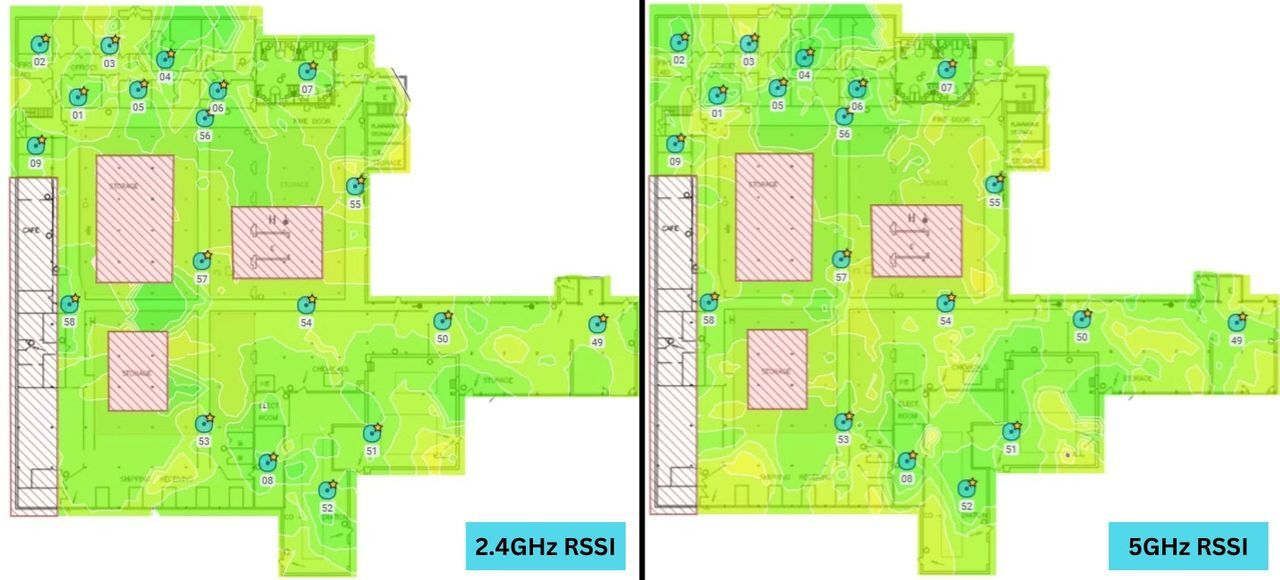
No Dead Zones, No Surprises: The Power of Pre-Deployment Insight, Ontario, Canada
Maintaining a robust and dependable wireless network is essential for operational efficiency, as illustrated by the case of a manufacturing plant in Ontario, Canada. Ongoing connectivity problems in the office, production, and warehouse areas were affecting productivity, leading to the necessity for a Wireless Pre-Deployment Site Survey. Utilizing Ekahau Survey Pro 11.4.1, the survey evaluated network performance, pinpointing weak signal zones, potential interference sources, and offering actionable insights for optimizing Wi-Fi coverage. This method underscores the significance of Wi-Fi Planning and Design in tackling connectivity issues and ensuring smooth operations.
Details of the Survey
Client Location and Issues Reported
Facility Type: Manufacturing plant with office / production / warehouse
Reported Issues: Poor signal strength, frequent disconnections, and inefficient Cisco Meraki AP placement.
Survey Duration: May, 2024
Site Details
Ceiling Heights: Up to 37’ in some warehouse areas.
Challenges Identified: Thick concrete walls, RF interference from machinery, and high user density zones.
Survey Type
Purpose: To identify weak signal areas, optimize network cabling, and ensure sufficient RF propagation.
Tools Used: Ekahau Site Survey, Spectrum Analyzer for RF analysis, and passive/active Wi-Fi health checks.
Signal Strength Comparison

Comparing 5GHz vs. 2.4GHz RSSI at -65dBm on the ground floor: Same threshold, different performance!
Survey Findings
During the site survey, the following technical issues were uncovered:
- Coverage Gaps: Several production and warehouse zones exhibited poor RSSI (< -65 dBm), leading to unreliable connectivity.
- Channel Congestion: Overlapping Wi-Fi channels in office areas contributed to signal interference and reduced throughput.
- Suboptimal AP Placement: Some access points were mounted too high (>32’), affecting effective signal propagation.
-
Limited Network Security Measures: Lack of rogue device detection increased vulnerability to unauthorized access.
Root Causes of Wireless Network Deficiencies
Wireless network inefficiencies often stem from a lack of strategic planning rather than hardware issues. Skipping comprehensive site surveys can lead to:
-
Electromagnetic Interference (EMI): Nearby networks, structural barriers, and industrial equipment disrupt signals, causing packet loss and reduced throughput. EMI sources like microwaves, Bluetooth devices, and fluorescent lights require spectral analysis before deployment.
-
Uneven Signal Distribution: Inconsistent signal strength due to architectural features like reinforced walls or high ceilings degrades user experience. Predictive RF modeling is essential to address these challenges.
-
Network Congestion: High device density, bandwidth-heavy applications, and alternative connected technologies strain networks, causing latency and bottlenecks.
Solutions and Recommendations
Based on the findings, we proposed a strategic Wi-Fi network optimization plan, which included:
1. Optimized AP Placement & RF Profile Adjustments
-
Relocate Cisco Meraki APs to ideal mounting heights for better RF coverage.
-
Optimize transmit power settings to reduce co-channel interference and ensure consistent SNR (>25 dB).
2. Structured Wiring Upgrades
-
Upgrade AP connections to CAT6A for improved throughput.
-
Ensure MDF/IDF installations are strategically placed to minimize cable runs (<295 feet per AP).
3. RF Interference Mitigation
-
Use a spectrum analyzer to identify rogue devices and sources of interference.
-
Implement adaptive RF management in the 5GHz band to enhance Wi-Fi stability in high-density areas.
4. Security Enhancements
-
Deploy Cisco Meraki’s advanced security features to mitigate unauthorized access.
-
Implement network segmentation to isolate guest and corporate traffic.
5. Future-Proofing for Scalability
-
Provision additional fiber optic cabling to accommodate future network expansion.
-
Schedule periodic Wi-Fi health checks to maintain network efficiency.
Final Thoughts
A Pre-Deployment Survey uses simulation tools, spectrum analysis, and field testing to identify and resolve these issues early, ensuring a robust, scalable network from the start. Optimizing your wireless network starts with a professional site survey. Whether you need to resolve connectivity issues, enhance security, or future-proof your network, our experts can help. A Wireless Pre-Survey is an essential first step in achieving a high-performance Wi-Fi network. By addressing the connectivity issues, we help create a robust, interference-free, and future-ready network.
Please get in touch with the experts at Orion US today.

Image Source: Canva
